Power Blog
PMICs with Integrated Passive Components

Contributed by: Stephen Russell
Since the launch of TechInsights’ power management integrated circuit (PMIC) Process Analysis channel at the end of 2021, we have analyzed a wide variety of devices. From high voltage gate drivers to automotive qualified converters to mobile PMICs. We have observed increasing attempts by manufacturers to incorporate passive components into PMIC products, in a co-packaged configuration or ‘fully integrated’ with the Si IC itself.
As with all power electronics, size, weight and power (SWaP) are key performance metrics. For a more efficient system we desire smaller, lighter and more power dense systems. Integration is highly desirable and theoretically possible at the relatively low power level PMICs operate at.
One type of device getting particular attention is the ‘integrated voltage regulator’ (IVR). A voltage regulator circuit acts to provide a constant stable voltage for delicate components such as a CPU, where even a relatively small variation could destroy the delicate transistors within.
The input voltage for many consumer electronics products is 12 V (or 48 V for more recent server architectures). A final ‘point of load’ (PoL) step-down conversion process within the product itself supplies the < 2 V generally needed for the CPU, GPU and other internal components. Architectures are becoming ever more complex requiring multiple inputs, having several voltage regulator circuits supplying different voltages, all of which take up valuable board space. To integrate this functionality would be of significant benefit.
Early Attempts at a ‘Fully-Integrated’ Voltage Regulator
Perhaps the most notable forays in this technology to date have been by Intel. Trying what they term a ‘fully-integrated voltage regulator’ (FIVR) solution for their 4th and 5th generation Core Microprocessors (Haswell and Broadwell). A paper presented at the 2014 APEC conference shows the attempted approach – integrating a non-magnetic inductor into the LGA package. A research paper from 2016 shows further details with different inductors discussed including uncoupled solenoid, interleaved solenoid, shielded plated through-hole (PTH) loop and 3DL. The paper concludes that in the future magnetic material may be necessary to keep pace with current density. An earlier presentation from 2011 shows research being undertaken into on-chip inductors including a magnetic CoZrTa envelope.
Intel moved away from the FIVR idea in their products from their 6th generation, one factor appears to be the additional heat generated from this approach so close to the CPU. There have been rumors of a reintroduction of this technology since, as evidenced by a presentation at VLSI 2022 they are still working on the concept in some form.
The Apple APL1028 IVR
Our teardown channel covers the most significant consumer electronics product releases in detail. Our analysis of the 2021 MacBook Pro 16-inch with M1 processor found the Apple APL1028 chip, located on the backside of the PCB within the heat enclosure for the M1 processor region. We have since produced a PMIC process analysis report on this device and the integrated inductor technology featured in our most recent PMIC briefing.
The APL1028 comes in a flip-chip ball grid array (FCBGA) package as shown in Figure 1.
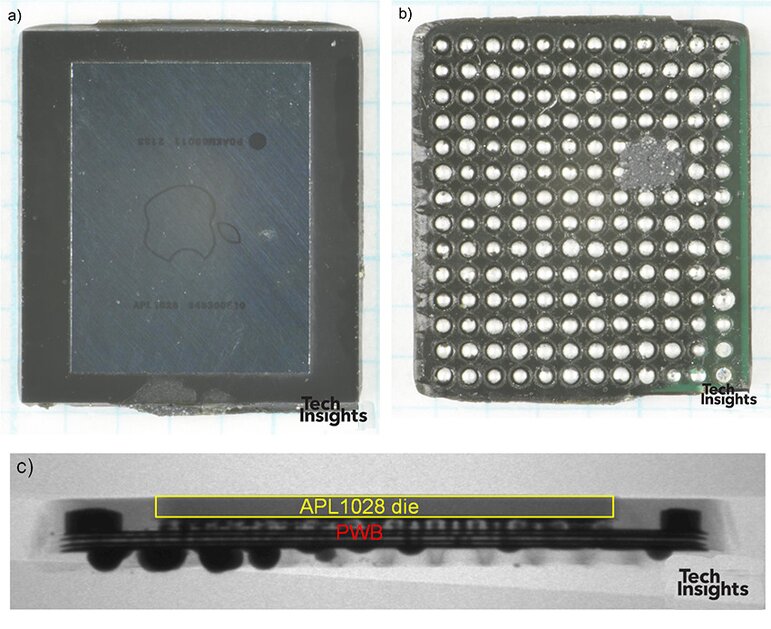
Figure 1 Apple APL1028 IVR in FCBGA package a) top b) bottom c) side-view X-ray with die highlighted
When removing the die from the package using an acid decapsulation process the result is an IC which our analysis suggests is likely the 12 FF process from TSMC. Note this is not a BCD PMIC, the integration of traditional bipolar devices or DMOS power transistors alongside FinFETs would necessitate a prohibitively large and expensive quantity of lithography masks. Given these parts operate at relatively low power levels the use of FinFET transistors alone is sufficient. The smallest ‘traditional’ PMIC logic node we have observed to date was ~ 55 nm also from an Apple product covered last year.
The real innovation can be seen when gradually removing the packaging. Figure 2 shows the package after polishing and a subsequent O2 etch process. Three rows of coupled inductors are revealed (28 in total).
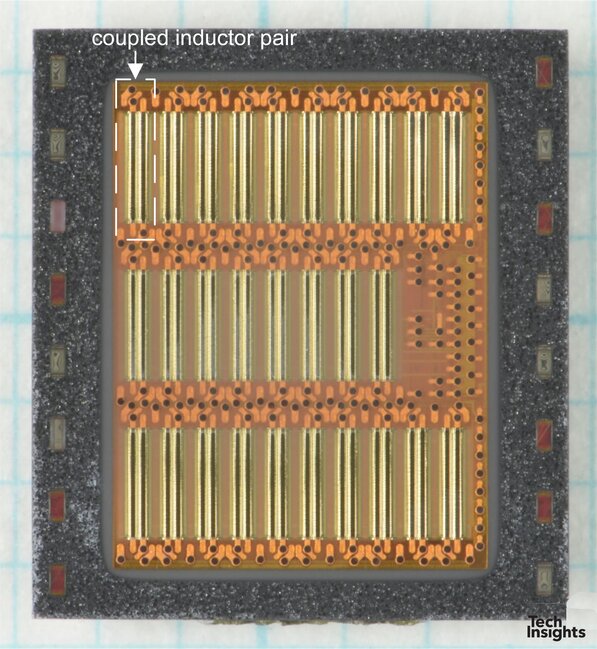
Figure 2 Polished package reveling on-chip inductor region
Each coupled inductor is formed in the RDL region of the device, two copper bars are surrounded by an envelope of magnetic material as shown in in Figure 3. One end of each copper bar connects through a via to the die while the other connects away towards the package.
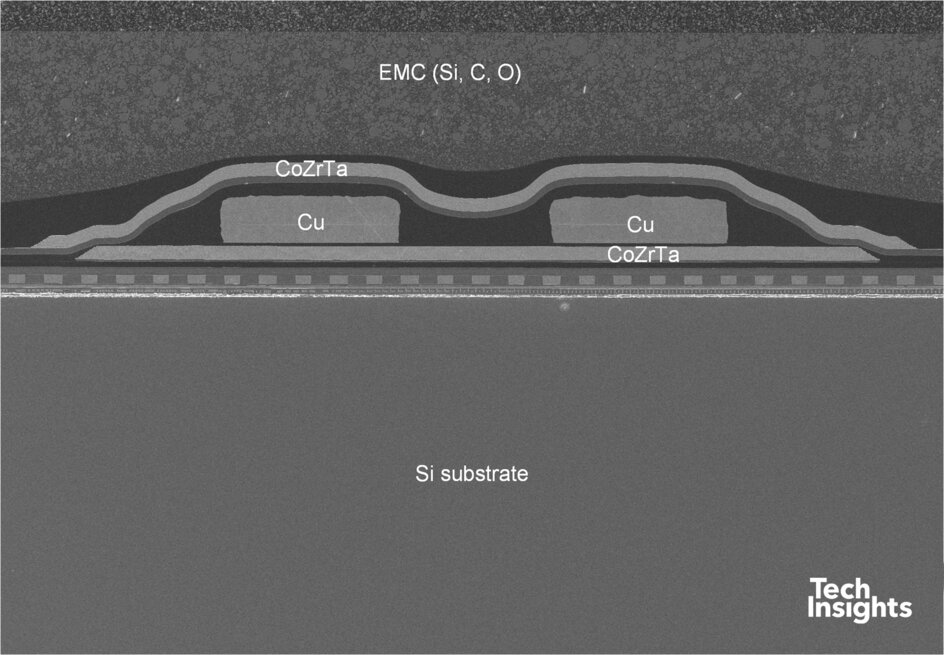
Figure 3 SEM cross-section of APL1028 die revealing coupled inductor with magnetic envelope
The concept is similar to that presented in the 2011 Intel research paper, even utilizing what appears to be the same CoZrTa magnetic material stack in the inductor envelope. Apple has managed to take this concept and incorporate it into a production device.
Another Integrated Voltage Regulator Example from Empower Semiconductor
We recently published a PMIC Process Analysis report on the Empower EP7037C triple output IVR. This product allows for multiple different regulated voltages to power different parts of a device. Empower has gone even further and more recently released a quadruple output deivce, the EP71xxx series. Empower claim their IVR technology allows for a 10x size reduction and 1000x faster operation. This improvement is due to the fact a traditional voltage regulator requires large output capacitors to acceptably filter transient repsonse. Empower claim their solution allows for processor power state changes in nanoseconds.
Figure 4 shows the FCBGA package alongside an X-ray showing the location of the ‘TRIO-C’ IC die along with four additional Si-deep trench capacitor die.
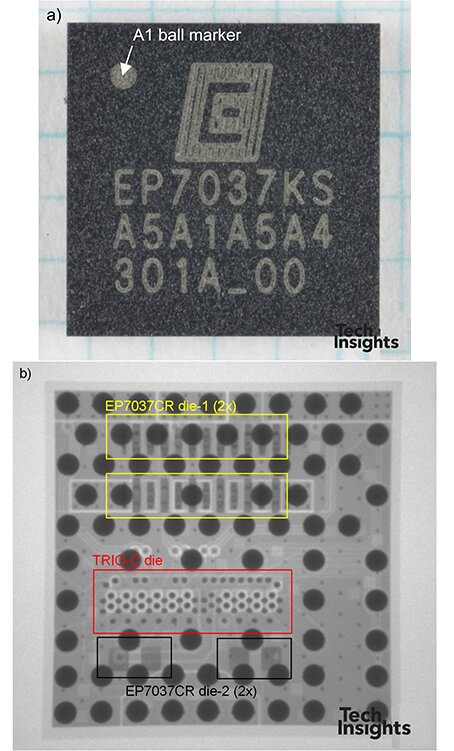
Figure 4 Empower EP7037C IVR a) FCBGA package b) Package X-Ray
This product shares some similarities with the Apple APL1028 IVR discussed in as seen earlier in this blog. Like the APL1028 we believe the ‘TRIO-C’ die seen here is likely based on a 12 FF process from TSMC. Their approach to integration differs however, here there is no on-chip inductor present. Instead Empower offers two solutions:
- A bespoke service in which they will assist with the design of a PCB with specialized inductor traces incorporated within
- Empower also offers the EP7037B which contains an inductor wound into the FCBGA package itself
The inclusion of four additional Si deep trench capacitor die is another method to cut down on additional passive components and board space. Figure 5 shows a scanning electron microscope (SEM) cross-section of one of these die. A two-metal aluminum process with tungsten-silicide contacts connects to polysilicon filled deep trenches forming the capacitors.
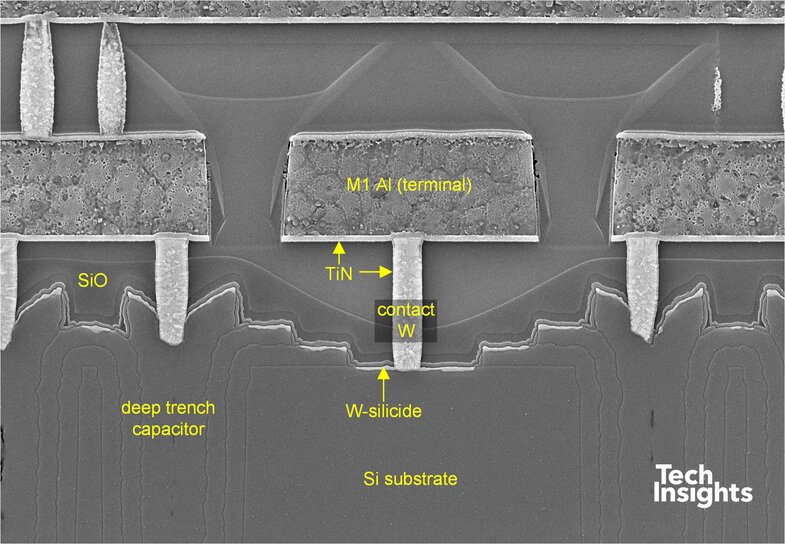
Figure 5 Si SEM cross-section of Si deep trench capacitor
Infineon Integrated Point of Load (IPOL) Buck Regulator
Moving away from IVRs we can see it is not just a single niche application where the integration of passive components can be of benefit. Infineon recently released the TDM3885 integrated point of load power module with a ‘fully integrated’ 4 A buck converter. Figure 6 shows various images detailing the internals of the PG-LGA-15 package with much more detail available in our power packaging report on this device.
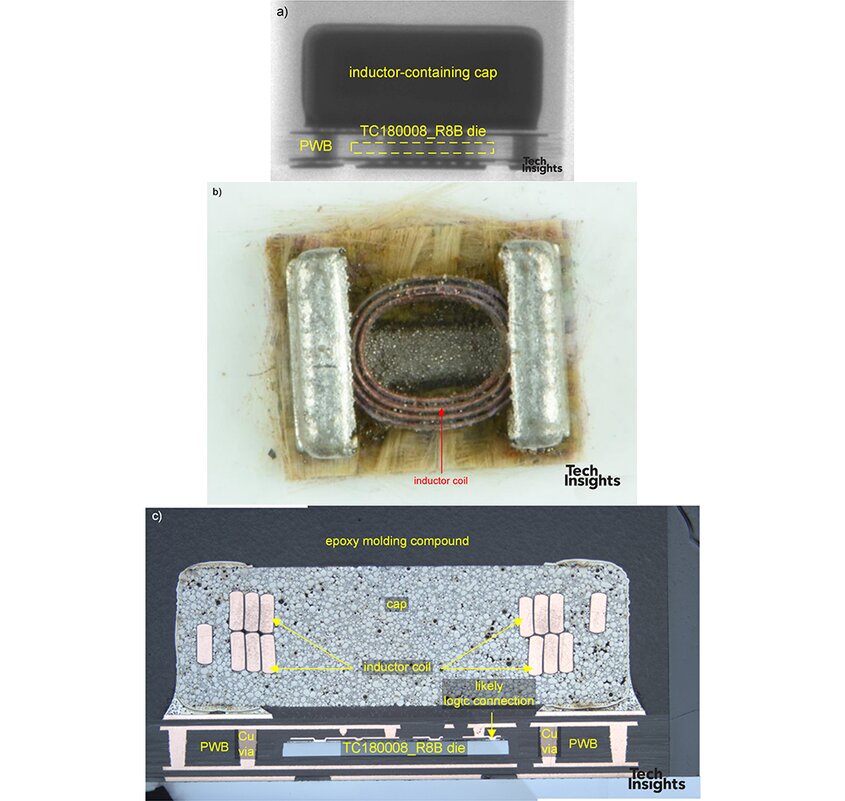
Figure 6 Infineon TDM3885 IPOL a) side-view package X-ray with die location identified b) package jet etch top-view with inductor coil revealed c) SEM cross-section of package showing both TC180008_R8B die and inductor coil
The TC180008_R8B die shown in Figure 7 does not contain a date marking on the die, however given it features an International Rectifier logo (bottom-right corner) it is fair to assume this is not a new IC design by Infineon. The innovation in this part is the inductor integration, which much like with IVRs can save valuable board space. This part is designed for final point of load (PoL) conversion within applications such as telecom and data centers, Infineon specifies it is suited to ‘space and thermally constrained application’. They claim it offers an 80% board area reduction with improved performance due to lower parasitics.
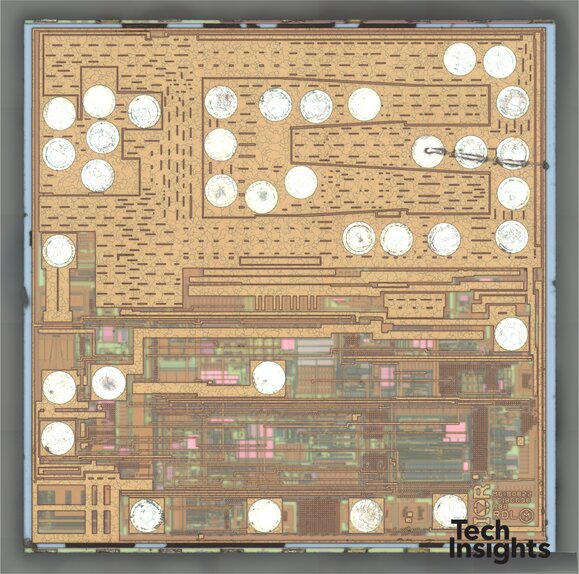
Figure 7 TC180008_R8B die image
Summary
The advantages of integrating passive components on to power chips are clear. The improvement in power density, minimization of board space and savings on bill of materials (BoM) are appealing. They are not without their challenges however and previous attempts at this technology were quickly discontinued.
It will be interesting to see if Apple carries on with this concept into their M2 Pro and Max MacBooks and the trade-offs they have made with thermal management.
The integrated voltage regulator (IVR) is by no means the only PMIC technology that can benefit from this approach. It is important when discussing any power conversion product, the system level performance, which if anything is even more important at higher power as fractions of a percent in efficiency savings become significant. This is important when discussing new wide bandgap products such as silicon carbide (SiC) and gallium nitride (GaN) transistors. The discrete transistors themselves may be more expensive than a silicon counterpart, yet not only do they offer improved performance at the transistor level, they also undoubtedly allow cost-savings in a larger system design. They achieve this by enabling higher frequency switching, in turn allowing for smaller capacitors and a cheaper, lighter, and more power dense solution. When we look at high power modules, we are increasingly seeing the importance of module layout and short interconnection to lower inductance.
There are also growing examples of novel packaging techniques to remove bondwires completely, see our power packaging report on Nexperia’s ‘copper-clip’ technology which removes bondwires for a low-voltage Si product, the PSMN3R9 100 V MOSFET.
When it comes to the lower power end of the spectrum and PMICs we can take this further by integrating the passives into the discrete package themselves and in the case of the Apple APL1028 actually on to the semiconductor die. We expect to see significant innovation in this regard over the next few years and we are excited to continue to share our findings with you!
References
- Infineon 650V high and low-side gate driver SOI technology PMIC Process Analysis Summary ( PEF-2109-801) TechInsights, 2021
- STMicroelectronics A6985F Automotive Synchronous Step-Down Switching Regulator PMIC Process Analysis Summary ( EXR-2106-805) TechInsights, 2021
- Samsung SPS26 0.13 μm BCD Mobile PMIC Power Essentials ( PEF-2204-803) TechInsights, 2022
- E. A. Burton et al, “FIVR — Fully integrated voltage regulators on 4th generation Intel® Core™ SoCs” 2014 IEEE Applied Power Electronics Conference and Exposition 16-24 March 2014.
- Package Inductors for Intel Fully Integrated Voltage Regulators ( IEEE…
- Integrated inductors with magnetic materials for on-chip power conversion IEEE…
- Fully Integrated Voltage Regulators with Package-Embedded Inductors for Heterogeneous 3D-TSV-Stacked System-in-Package with 22nm CMOS Active Silicon Interposer Featuring Self-Trimmed, Digitally Controlled ON-Time Discontinuous Conduction Mode (DCM) Operation IEEE…
- Apple APL1028 Integrated Voltage Regulator PMIC Power Essentials Analysis ( PEF-2204-802) TechInsights, 2022
- PMIC Process Analysis Tri-Annual Briefing ( BRF-2112-824) TechInsights, July, 2022
- Cirrus Logic 55 nm PMIC Products Observed in the Market ( TechInsights) 2021.
- Empower EP7037C Triple Output 10 A Packaged Integrated Voltage Regulator Power Management Integrated Circuit ( PEF-2202-802) TechInsights, 2022
- EP7037C Triple Output 10 A Packaged IVR ( Empower Website) 2022
- EP7037BTriple Output Integrated Voltage Regulator on Interposer ( Empower Website) 2022
- Empower Inductor Design Request ( Empower Website) 2022
- Empower Semiconductor Expands Family of Ultra-Compact Integrated Voltage Regulators (IVRs) with Launch of First Quad-Output Series ( Empower Website) 2022
- TDM3885 IPOL 4 A single output high-efficiency buck regulator module with integrated inductor ( Infineon Website) 2022
- Infineon TDM3885XUMA1 Integrated Point of Load 4 A Buck Regulator with Integrated Inductor ( PKG-2207-804) TechInsights, 2022
- Nexperia PSMN3R9 100 V Si MOSFET Power Package Analysis ( PKG-2108-803) TechInsights, 2021
- PSMN3R9-100YSF NextPower 100 V, 4.3 mOhm, 120 A, N-channel MOSFET in LFPAK56E package ( Nexperia Website) 2022










